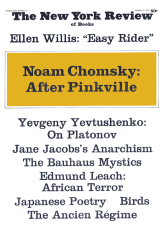In response to:
Words Enough from the December 4, 1969 issue
To the Editors:
W. V. Quine’s review of The Random House Dictionary of the English Language—College Edition in your December 4, 1969 issue contains a major, damaging inaccuracy which requires correction. Mr. Quine estimates the entries in our book at 100,000. As clearly stated on the back of our dust jacket and on the front flap, the RHDC contains well over 155,000 entries—more entries than any college dictionary ever published, bar none. Our book also has thousands more actual definitions than any other college dictionary ever published, bar none. We have advertised our book since its publication last year as having more entries and definitions and fuller definitions than any other college dictionary and are continuing to do so with complete honesty.
There are other mistakes in the review. For example, the RHDC is based on our unabridged Random House Dictionary and contains 1500 new illustrations which do not appear in our American College Dictionary. The damaging mistake your reviewer made, however, is on our contents—the RHDC contains over 155,000 entries, more entries than any other college dictionary.
Stuart B. Flexner
Vice President
Reference Department
Random House, Inc.
New York City
W.V Quine replies:
What does Mr. Flexner count as an entry? Evidently not the separate and alphabetized entries of the main body of his dictionary. Counting five random pages, I get an average of 46 such entries per page; and this figure times 1534 pages gives fewer than 71,000.
Not that I used this method when I wrote the review. I simply said how many entries the American Heritage Dictionary claimed, and then scaled that figure down to the Random House College Edition roughly by relative page capacity (the number of pages being equal). The type format of the American Heritage Dictionary is 390 square centimeters in area (plus the pictorial margin), as against 316 for the Random House College Edition; and then I allowed further for the fact that the Random House pictures preempt entry space, whereas the American Heritage pictures do not.
In this scaling I was interested only in relative size, and not in what one or another dictionary counted in counting entries; I remarked in my very next paragraph, indeed, on the arbitrariness of that concept. Now that an issue is being made, however, I perceive that I can concede this much to Mr. Flexner: my size comparison failed to allow for the fact that the type in the Random House College Edition is somewhat smaller than that in the American Heritage. I do not think Mr. Flexner would want to argue that the type is much smaller.
Mr. Flexner remarks that his dictionary was represented, when it came out, as containing “more entries than any college dictionary ever published, bar none.” Bar, however, possible future dictionaries. The American Heritage Dictionary came out the next year.
He claims “there are other mistakes in the review,” and then states as an “example” that his College Edition is based on his Unabridged and contains 1500 illustrations not in the American College Dictionary. The mistake is Mr. Flexner’s, in misrepresenting these assertions of his as corrections of mistakes of mine. For I wrote that the illustrations were “inherited selectively from the Unabridged,” and I did not deny that they were new to the American College Dictionary. I did remark that “many are merely redrawn with the creature facing another way.” I should be puzzled if Mr. Flexner were to deny this.
This Issue
January 1, 1970



